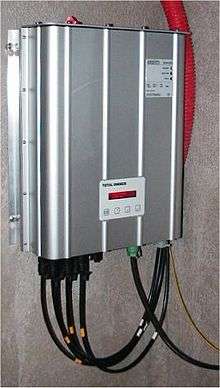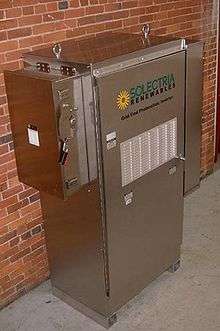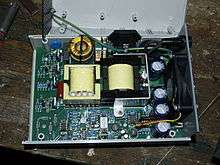Grid-tie inverter


A grid-tie inverter is a power inverter that converts direct current (DC) electricity into alternating current (AC) with an ability to synchronize to interface with a utility line. Its applications are converting DC sources such as solar panels or small wind turbines into AC for tying with the grid.[1]
Residences and businesses that have a grid-tied electrical system are permitted in many countries to sell their energy to the utility grid. Electricity delivered to the grid can be compensated in several ways. "Net metering" is where the entity that owns the renewable energy power source receives compensation from the utility for its net outflow of power. So for example, if during a given month a power system feeds 500 kilowatt-hours into the grid and uses 100 kilowatt-hours from the grid, it would receive compensation for 400 kilowatt-hours. In the US, net metering policies vary by jurisdiction. Another policy is a feed-in tariff, where the producer is paid for every kilowatt hour delivered to the grid by a special tariff based on a contract with distribution company or other power authority.
In the United States, grid-interactive power systems are covered by specific provisions in the National Electric Code, which also mandates certain requirements for grid-interactive inverters.
Typical operation
Inverters take DC power and invert it to AC power so it can be fed into the electric utility company grid. The grid tie inverter (GTI) must synchronize its frequency with that of the grid (e.g. 50 or 60 Hz) using a local oscillator and limit the voltage to no higher than the grid voltage. A high-quality modern GTI has a fixed unity power factor, which means its output voltage and current are perfectly lined up, and its phase angle is within 1 degree of the AC power grid. The inverter has an on-board computer which senses the current AC grid waveform, and outputs a voltage to correspond with the grid. However, supplying reactive power to the grid might be necessary to keep the voltage in the local grid inside allowed limitations. Otherwise, in a grid segment with considerable power from renewable sources, voltage levels might rise too much at times of high production, i.e. around noon.
Grid-tie inverters are also designed to quickly disconnect from the grid if the utility grid goes down. This is an NEC requirement[2] that ensures that in the event of a blackout, the grid tie inverter will shut down to prevent the energy it transfers from harming any line workers who are sent to fix the power grid.
Properly configured, a grid tie inverter enables a home owner to use an alternative power generation system like solar or wind power without extensive rewiring and without batteries. If the alternative power being produced is insufficient, the deficit will be sourced from the electricity grid.
Technology

Technologies available to grid-tie inverters include newer high-frequency transformers, conventional low-frequency transformers, or they may operate without transformers altogether. Instead of converting direct current directly to 120 or 240 volts AC, high-frequency transformers employ a computerized multi-step process that involves converting the power to high-frequency AC and then back to DC and then to the final AC output voltage.[3] Transformerless inverters are both lighter and more efficient than their counterparts with transformers, are popular in Europe. However, transformerless inverters have been slow to enter the US market over concerns that transformerless electrical systems could feed into the public utility grid without galvanic isolation between the DC and AC circuits that could allow the passage of dangerous DC faults to be transmitted to the AC side.[4] However, since 2005, the NFPA's NEC allows transformerless (or non-galvanically) inverters by removing the requirement that all solar electric systems be negative grounded and specifying new safety requirements. The VDE 0126-1-1 and IEC 6210 also have been amended to allow and define the safety mechanisms needed for such systems. Primarily, residual or ground current detection is used to detect possible fault conditions. Also isolation tests are performed to ensure DC to AC separation.
Characteristics
Inverter manufacturers publish datasheets for the inverters in their product line. While the terminology and content will vary by manufacturer, datasheets generally include the following information:
- Rated output power: This value is provided in watts or kilowatts. For some inverters, they may provide an output rating for different output voltages. For instance, if the inverter can be configured for either 240 VAC or 208 VAC output, the rated power output may be different for each of those configurations.
- Output voltage(s): This value indicates to which utility voltages the inverter can connect. For smaller inverters that are designed for residential use, the output voltage is usually 240 VAC. Inverters that target commercial applications are rated for 208, 240, 277, 400, 480 or 600 VAC and may also produce three phase power.
- Peak efficiency: The peak efficiency represents the highest efficiency that the inverter can achieve. Most grid-tie inverters on the market as of July 2009 have peak efficiencies of over 94%, some as high as 96%. The energy lost during inversion is for the most part converted into heat. Consequently, in order for an inverter to output its rated power it will require a power input that exceeds its output. For example, a 5000 W inverter operating at full power at 95% efficiency will require an input of 5,263 W (rated power divided by efficiency). Inverters that are capable of producing power at different AC voltages may have different efficiencies associated with each voltage.
- CEC weighted efficiency: This efficiency is published by the California Energy Commission on its GoSolar website. In contrast to peak efficiency, this value is an average efficiency and is a better representation of the inverter's operating profile. Inverters that are capable of producing power at different AC voltages may have different efficiencies associated with each voltage.[5]
- Maximum input current: This is the maximum amount of direct current that the inverter can use. If a system, solar cells for example, produces a current in excess of the maximum input current, that current is not used by the inverter.
- Maximum output current: The maximum output current is the maximum continuous alternating current that the inverter will supply. This value is typically used to determine the minimum current rating of the over-current protection devices (e.g., breakers and fuses) and disconnects required for the output circuit. Inverters that are capable of producing power at different AC voltages will have different maximum outputs for each voltage.
- Peak power tracking voltage: This represents the DC voltage range in which the inverter's maximum point power tracker will operate. The system designer must configure the strings optimally so that during the majority of the year, the voltage of the strings will be within this range. This can be a difficult task since voltage will fluctuate with changes in temperature.
- Start voltage: This value is not listed on all inverter datasheets. The value indicates the minimum DC voltage that is required in order for the inverter to turn on and begin operation. This is especially important for solar applications, because the system designer must be sure that there is a sufficient number of solar modules wired in series in each string to produce this voltage. If this value is not provided by the manufacturer, system designers typically use the lower band of the peak power tracking voltage range as the inverter's minimum voltage.
- IPxx rating: The Ingress Protection rating or IP Code classifies and rates the level of protection provided against the ingress of solid foreign objects (first digit) or water (second digit), a higher digit means greater protection. In the US the NEMA enclosure type is used similarly to the international rating. Most inverters are rated for outdoors installation with IP45 (no dust protection) or IP65 (dust tight), or in the US, NEMA 3R (no windblown dust protection) or NEMA 4X (windblown dust, direct water splash and additional corrosion protection).
See also
References and further reading
- ↑ http://www.osti.gov/bridge/servlets/purl/463622-TtEMSp/webviewable/463622.pdf OSTI
- ↑ NEC Handbook 2005, Section 705, "Interconnected Electric Power Production Sources," Article 705.40 "Loss of Primary Source"
- ↑ Solar Energy International (2006). Photovoltaics: Design and Installation Manual, Gabriola Island, BC: New Society Publishers, p. 80.
- ↑ "Summary Report on the DOE High-tech Inverter Workshop" (PDF). Sponsored by the US Department of Energy, prepared by McNeil Technologies. eere.energy.gov. Retrieved 2011-06-10.
- ↑ gosolarcalifornia.org, "List of Eligible Inverters", accessed July 30, 2009,
External links
- California List of Eligible Inverters - This is the official California Energy Commission (CEC) list of inverters that are eligible for California's rebate program. Other states use this list as well.
- Grid Tie Inverter Comparison Tool - website that allows people to compare the data sheets of various grid-tie inverters. One can also use the website to filter and search inverters by technical data.
- Grid-Tie Wind Inverters Versus Solar Inverters - describes in detail the differences between existing grid tied inverters.